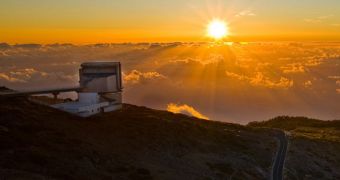Recently, the American space agency announced that the Kepler Space Telescope has discovered more than 1,200 exoplanet candidates thus far. Now, telescopes around the world participate in confirming the existence of these objects.
In order for a body to be classified as a candidate, reasons must exist for astronomers to believe that the objects the are exoplanets. However, at this stage of the survey, that this is not certain.
The next step after identifying candidates is confirming that they actually exist. This is done very meticulously, by ground- and space-based telescopes alike, Universe Today reports.
The observatories are pointed at the stars Kepler identified as harboring potential exoplanets, and then they wait for as long as they have to. The idea here is to catch a glimpse of the same stellar occultations that the NASA telescope found when it surveyed those particular stars.
These occultations appear when an exoplanet passes in front of its parent star, as seen from our point of view. If astronomers detect 2 or 3 such events at regular intervals, then that star features an object in its orbit.
Given that comets or asteroids are too small to be detected, the objects are classified as exoplanets. The international astronomical community has a monumental task ahead, when considering the large number of candidates that the planet-hunting mission set forth.
But help is on the way. Starting in April 2012, the 3.6-meter Telescopio Nazionale Galileo (TNG) in the Canary Islands will receive a new spectrograph instrument, called HARPS-North.
“The Kepler mission gives us the size of a planet, based on the amount of light it blocks when it passes in front of its star. Now we need to measure planetary masses, so that we can calculate the densities,” explains David Latham.
“That will allow us to distinguish rocky planets and water worlds from ones dominated by atmospheres of hydrogen and helium,” adds the astronomer, who is based at the Harvard-Smithsonian Center for Astrophysics (CfA).
The High-Accuracy Radial velocity Planet Searcher spectrograph will be an exact duplicate of the one installed on the 3.6-meter European Southern Observatory (ESO) telescope, in La Silla, Chile.
“We have set up an enthusiastic collaboration among various institutions to build a northern copy of HARPS. We all expect HARPS-N to be as successful as its southern ‘brother’,” says HARPS-N principal investigator Francesco Pepe.
“HARPS-N will pursue the most interesting targets found by Kepler, at a level that no one else in the world can do,” explains the director of the Harvard Origins of Life Initiative, Dimitar Sasselov.
“HARPS-N will partner with Kepler to characterize worlds enough like Earth that they might be able to support life as we know it,” he concludes.

 14 DAY TRIAL //
14 DAY TRIAL //